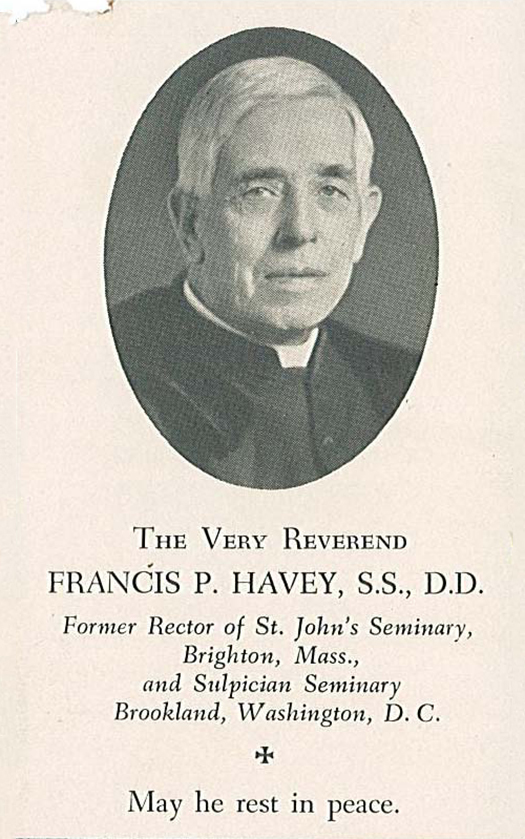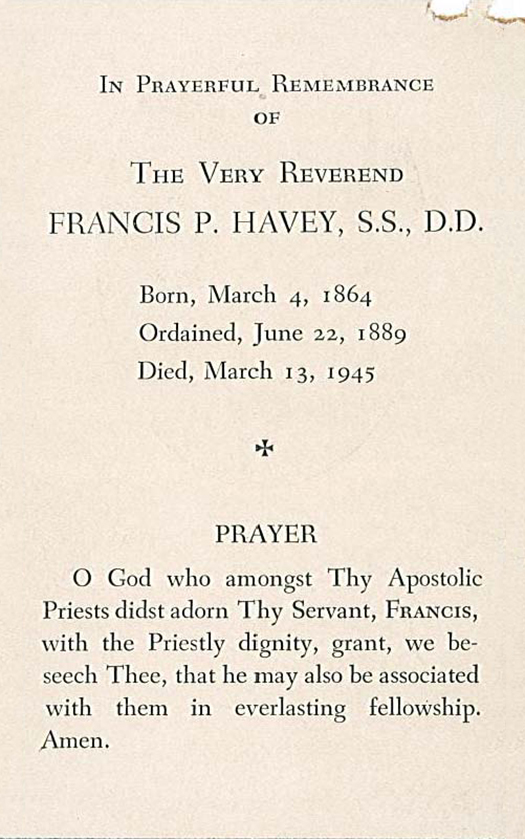Havey, Father Francis
1945, March 13
Date of Birth: 1864, May 10
Paris
March 23, 1946
Fathers and Dear Confreres:
The priest of St. Sulpice whose obituary notice I here undertake is one of those who have exercised the most profound influence in our Sulpician houses in the United States. It has been said of him: “He is a mystic.” And that is so. He seemed to be serving Our Lord in ways other than ours. Without the least hesitation he made decisions which quieted uneasiness and brought peace. In all the advice he gave to those who came to consult him, it seemed as if the Holy Spirit were very artfully inspiring him. He seemed to live in closeness to God. Ready for more than eighty years on earth, he returned to his Creator and Father with the simplicity of a child. That priest was Father Havey.
Francis Patrick Havey was born in Ireland at Clonard, County Heath, on May 10, 1864. There were six children in his family; Francis was the youngest. He was six years old when the family moved from Ireland to the United States and settled in New Haven, Connecticut. A great sorrow came to the family shortly after it came to America: the father died suddenly. Fortunately, Mrs. Havey’s family back in County Heath came to the aid of the exiles. But that did not keep poverty from looming large in the home. However, thanks to her work, the mother knew some joy from being able to provide a very good education for her children. In addition to that, they themselves had to help out. Like his brothers and sisters, little Francis worked in his spare time. As a regular thing he sold papers. Besides that, he worked for the city putting out gas lamps. But his work did not keep him – nor his brothers and sisters – from continuing their grade school studies. All that little world was within the boundaries of St. John’s parish. Francis Patrick went to its school from 1875 to 1879.
His vocation was without “ups and downs.” It remained so to the end. He was one of those souls “naturally priestly,” who go straight up the road to Our Lord’s altar, so convinced are they that Christ wants them for the Church and for God. He was ordained priest for the Diocese of Hartford in 1889.
Named as assistant at the Cathedral of that diocese, Father Havey fulfilled his functions with regularity and with a peaceful and calm zeal which won him the esteem and affection of all. He was happy. He made others happy there. How did he come to think of another ministry? According to the half-confidences that he sometimes made, it seems that it was his pastor, Father Harty of the Hartford Cathedral, who set him on the right road. They were both on the way to make a pilgrimage to the shrine of St. Anne de Beaupré near Quebec. While there, Father Harty asked him if he had ever thought of entering a religious order such as the Jesuits, which they both loved. Bishop [?] Shahan put the same question to him; and as that prelate dearly loved the Society of St. Sulpice, he offered to intercede with the Superior of St. Mary’s Seminary in Baltimore, Father Magnien, on Father Havey’s behalf. This was a flash of light for Father Havey. He replied that he knew the Sulpicians when he was being trained by them at Brighton, and that he would go to consult his former director, Father Hogan. If you take Father Havey at his word, Father Hogan was not at first enthusiastic. It seemed to him that Father Havey was not cut out for the Society. Father Havey gently persisted and humbly suggested, not without a trace of humor, that perhaps he could be trusted in a seminary with a class of Church History, couldn’t he? Father Hogan let himself be convinced. Father Havey was accepted!
Great excitement stirred in the Diocese of Hartford where he was already so loved! But no one would ever want to stand in the way of a Sulpician vocation! Quite the contrary. Father Havey’s friends collected eight hundred dollars among themselves and offered it to him to help him in supporting his mother. A holy nun in Hartford, on hearing the news, encouraged him thus: “Go to St. Sulpice and visit the world.” At the same time, she made her vows before him and promised to keep him in her prayers.
Father Havey left for Europe in 1896. He went first to Ireland to visit those of his family who had stayed there. At Clonard he was given a royal reception. He celebrated Mass in the old church where his forebears had been baptized, and he was charmed by the delicate and deep Catholicism of the people. Children and adults made him welcome. Later, sadly, he often said: “Oh, how pleasant it was at Clonard! I have found it hard to excuse those who made me go away from it!”
From Ireland he came to Paris. That was the purpose of his voyage. For some months he resided at St. Jean’s and attended the courses at the Catholic Institute. After that, Father Captier, Superior General, decided that he would begin his Solitude. He therefore came to Issy where he found, among other confreres, Fathers Brulé and Viéban, who were to follow him to America.
His Solitude over, he received permission to go to Lourdes before returning to the United States. He intended to stay there only for a brief time. But he was so taken by the natural attractiveness of the holy town that he stayed there as long as possible.
On his return to the United States, he was appointed teacher of Church History at Dunwoodie. He was being given a hard job. He set about it with enthusiasm and courage. Soon success crowned his efforts. The seminarians liked the teacher who worked stubbornly to make the history of the Catholic Church in the world and in their own country worthwhile and interesting. It is known that he neglected nothing in tracking down material whose documentation, at that time in the United States, was rather scarce. Readily he made available to his students his books, his notes, sometimes this or that document which he was making use of. Their enthusiasm grew both for the teacher’s classes and for the teacher himself.
Very soon, Father Havey was named Superior of Philosophy. To his teaching of History he added that of Ascetics. There again, by reason of the scarcity of books on that subject, he put together a course for the benefit of his students.
Father Havey’s stay at Dunwoodie began in 1898. It ended in 1904. That year he was made Superior of Philosophy and teacher of Moral at St. Joseph’s [sic] in Brighton. He lasted two years in that post. After the death of Father Maher in 1906, he became Superior of Theology and remained so until 1911.
At that time it was decided that a “Solitude” be opened in the United States for future American Sulpicians. It was Father Havey who was picked to open it. With that in mind, he came back to France where, for some months, he trained himself for his future ministry and familiarized himself with the duties of his new office. He filled that office for two years: in 1911-1912, and in 1913-1914. In principle, the American Solitude was to be in operation only every two years. In between, he taught Latin at St. Charles. There he was Superior for a few months following the death of Father McKenny.
From 1915 to 1917 he taught Moral Theology at St. Mary’s Seminary on Paca Street in Baltimore. Then he was sent with the fourth-year theologians to Brookland Station in Washington. At Father Dyer’s request he laid there the foundation of the Sulpician Seminary, whose first Superior he became.
It was then that his health started to decline and he had to undergo a serious operation. After that, his physical condition had its ups and downs. He was appointed to St. Mary’s Seminary where he did a little teaching and acted as Spiritual Director. He continued so up to the time of his retirement to Roland Park.
There, little by little, he grew weaker. At the end of 1942 or the beginning of 1943, Father Havey had to be taken to Baltimore’s St. Agnes Hospital. His illness was a puzzling one. For months he was bedridden, hardly conscious, and seeming to rouse himself a little only when certain friends came to visit. He did not appear to be suffering much. But the weakness of his chest, his advanced age, and some other symptoms disabused those about him of any hope of recovery. He died quietly at St. Agnes Hospital on March 13, 1943 [sic] shortly before six o’clock in the evening.
That was the day before the ordination retreat at St. Mary’s Seminary. The body of the deceased was brought there and laid out in the parlor. There, an honor guard waked him until March 16th, the day of the funeral. His presence in that house at such a time was, as one of our confreres remarked, his last ordination sermon to the seminarians.
After the funeral, Father Havey’s body was carried to St. Charles where it rests in the little cemetery so often hallowed by his prayers.
Please, Fathers and dear confreres, remember Father Havey before God, and accept, I beg you, the assurance of my fraternal affection in Our Lord.
P. Boisard
Superior General of the Society of St. Sulpice


